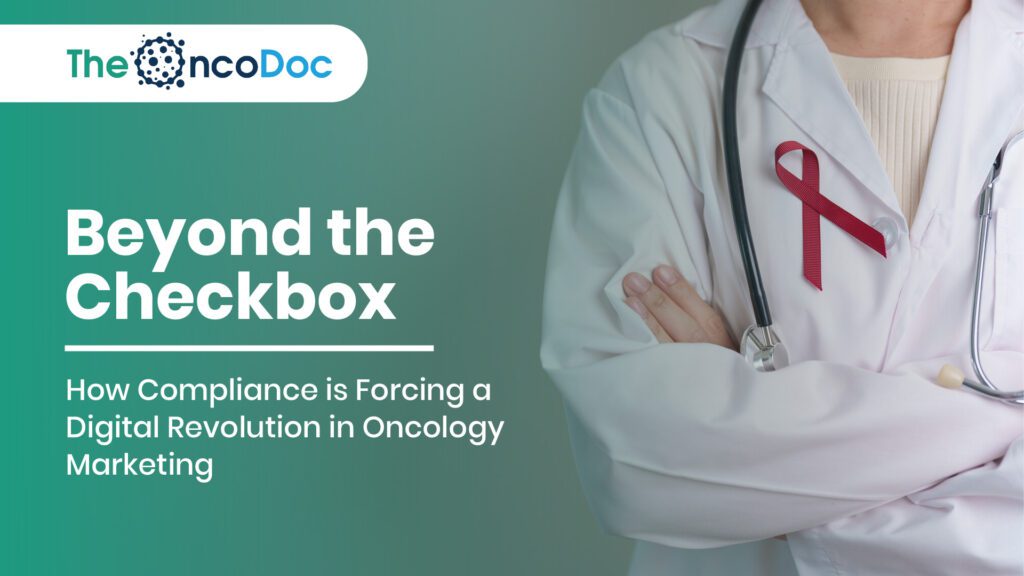Abstract
The digital frontier of medical oncology marketing, once a landscape of unbridled innovation, is now being meticulously mapped and regulated by a growing body of compliance requirements. This article provides a comprehensive analysis of how these non-negotiable compliance needs are not just an operational burden but a catalyst for a fundamental digital transformation in oncology and the broader pharmaceutical industry. We delve into the complex interplay between regulations like HIPAA, GDPR, and FDA guidelines and their direct impact on everything from content moderation and data privacy to the very architecture of digital platforms. For an audience of doctors and pharma managers, we explore how this shift is compelling the adoption of new technologies—from AI-powered monitoring to blockchain-based data management—and a new set of compliance-focused analytics. The article argues that this era of stringent oversight is ultimately leading to more trustworthy, ethical, and effective digital strategies that benefit all stakeholders, ensuring that the pursuit of scientific communication is matched by an unwavering commitment to patient safety and data integrity.
Introduction: The Unseen Architect of Digital Strategy
For many years, the primary drivers of digital marketing strategy in the pharmaceutical sector were engagement, reach, and conversion. A new app, a groundbreaking social media campaign, or a viral video were celebrated for their ability to break through the noise and connect with doctors and patients. However, a new, more powerful force has emerged as the chief architect of digital strategy: compliance. In the high-stakes world of oncology, where patient data is among the most sensitive and the consequences of misinformation are severe, the need to adhere to a complex and ever-changing web of regulations is paramount. This imperative is no longer a footnote in a marketing plan; it is the headline.
This article is for the pharma manager navigating this new reality and the doctor who relies on compliant, trustworthy information. We will demonstrate how regulations like the FDA’s guidance on social media, the EU’s GDPR, and the U.S.’s HIPAA are not acting as a brake on innovation, but rather as a crucible for a more thoughtful, strategic, and ultimately more effective digital approach. We will explore how companies are leveraging sophisticated analytics to measure not just the success of a campaign, but its adherence to regulatory standards, thereby building a new model of digital marketing where integrity is the ultimate metric of success.
Part I: The Compliance Imperative – Navigating the Regulatory Minefield
The foundation of any compliant digital strategy is a deep understanding of the regulatory landscape. For oncology marketers, this includes a layered set of rules that govern everything from the content of a tweet to the security of a patient’s data.
1. FDA and its Digital Demands: The FDA’s rules are foundational for any U.S.-based marketing. Its guidance on social media and digital promotions focuses on the balance of providing accurate information while ensuring all content includes risk and benefit information in a clear and consistent manner.
- Impact on Strategy: This forces marketers to be incredibly disciplined in their content creation. Every digital asset, from a tweet to a blog post, must go through a rigorous medical-legal-regulatory (MLR) review process. This has led to a shift away from fast-paced, real-time social media content and towards a more structured, pre-approved editorial calendar. The spontaneous, conversational tone that works in other industries is a non-starter here.
2. HIPAA and the Sanctity of Patient Data: The Health Insurance Portability and Accountability Act (HIPAA) governs the protection of sensitive patient health information (PHI). In the digital age, where data is the fuel of marketing, this has monumental implications.
- Impact on Strategy: HIPAA compliance has reshaped the entire architecture of digital engagement. Marketers can no longer casually collect patient data via unprotected web forms or email. Patient support programs, once managed via simple websites, are now built on secure, encrypted platforms. The use of cookies and other tracking technologies must be carefully reviewed to ensure they do not inadvertently collect PHI.
3. GDPR, CCPA, and Global Privacy: The European Union’s General Data Protection Regulation (GDPR) and the California Consumer Privacy Act (CCPA) have set a global standard for data privacy. These regulations grant individuals more control over their personal data and mandate transparency in how that data is collected, used, and stored.
- Impact on Strategy: For global oncology marketers, this has forced a unified, privacy-first approach. Campaigns must be designed to be compliant with the strictest global standards. Opt-in consent for email marketing, clear privacy policies, and the ability for users to easily access and delete their data are no longer a best practice; they are a legal requirement.
Part II: Reshaping the Digital Strategy – The New Operational Model
Compliance needs are not just adding a layer of red tape; they are fundamentally reshaping the operational model for digital oncology marketing.
1. The Rise of “Walled Gardens” and Closed Platforms: The open web and public social media platforms are a compliance risk. As a result, many pharma companies are moving toward creating their own “walled garden” platforms—secure, brand-owned digital ecosystems where they can control the data, the conversation, and the content.
- Impact: These platforms can be patient portals, educational hubs for HCPs, or branded apps. Within these closed environments, marketers can engage more freely, with the assurance that all interactions are monitored, compliant, and data-secure. While this may limit the reach of a campaign, it drastically reduces the risk.
2. The Shift to Pre-Approved, Multi-Modal Content: Real-time social media is challenging for compliance. Instead, marketers are creating a library of pre-approved, evergreen content in various formats—infographics, videos, interactive tools—that can be deployed as needed.
- Impact: This content is often designed to be modular. A single piece of core clinical data can be presented as a video for a patient, an interactive chart for a doctor, and a key takeaway in an email. This reduces the time and cost of the MLR review process while ensuring consistency and compliance across all channels.
3. The Integration of Legal and Regulatory into Marketing: In the past, legal and regulatory teams were seen as a final checkpoint. Today, they are integrated into the marketing process from the very beginning.
- Impact: This ensures that compliance is a core design principle, not a last-minute fix. A marketing team’s “sprint” now includes a dedicated regulatory member who can provide real-time guidance, accelerating the approval process and reducing the likelihood of a costly error.
Part III: The Role of Technology and Analytics – Measuring Integrity
In a compliant-first world, analytics has a new and critical role: it’s used not just to measure marketing performance but to measure compliance itself.
1. AI for Proactive Monitoring: AI-powered tools are now used to proactively monitor digital channels for compliance risks. These tools can scan social media for off-label discussions, monitor forums for adverse event reports, and flag potentially non-compliant content before it becomes a problem.
- Impact: This technology transforms compliance from a reactive, manual process into a proactive, automated one. It allows marketing teams to scale their digital presence without scaling their risk. The analytics from these tools provide real-time insights into the “health” of a brand’s digital footprint from a regulatory perspective.
- Key Metrics: MLR Review Cycle Time, Compliance Violation Flags, and Adverse Event Report Identification Rate.
2. Blockchain for Data Integrity: As the use of patient-consented data in marketing becomes more prevalent, the need for an unchangeable and transparent record of that consent is crucial. Blockchain technology offers a solution.
- Impact: Blockchain can be used to create a decentralized, immutable ledger of a patient’s data consent. This provides an indisputable audit trail, ensuring that a patient’s data is only used in ways they have explicitly agreed to. For marketers, this builds a new level of trust and provides a robust defense against privacy claims.
- Key Metrics: Consent Audit Trail Completion Rate, Data Provenance Score, and Privacy Violation Incidents.
3. The Rise of Compliance-Focused Analytics Dashboards: A modern pharma marketing dashboard now includes a “compliance score” alongside traditional metrics like engagement and conversion.
- Impact: This dashboard tracks a variety of compliance-related KPIs, giving pharma managers a clear, real-time view of their digital risk profile. It forces teams to think about compliance not as a separate task but as a core component of their overall performance. The analytics demonstrate that a campaign can be both highly effective and highly compliant.
- Key Metrics: Digital Risk Score, MLR Cycle Time Improvement, and Data Privacy Incident Rate.
Part IV: The Impact on Doctors and Pharma Managers
The move towards a compliant-first digital strategy has profound and positive implications for the target audience.
1. For Doctors: The shift means that the digital content they receive is more trustworthy and reliable. The information is backed by a rigorous MLR review process and is free from the kind of hyperbolic, off-label claims that can proliferate on less-regulated platforms. It ensures they are receiving high-quality, scientifically sound information that helps them make better-informed decisions for their patients.
2. For Pharma Managers: Compliance is a new source of competitive advantage. A brand known for its rigorous commitment to compliance and data privacy will build a stronger reputation and earn greater trust from HCPs and patients. It also creates an opportunity to streamline processes, reduce costs associated with regulatory fines, and build more secure and effective digital ecosystems. The investment in compliance technologies is not an expense; it is a strategic investment in the long-term health and reputation of the brand.
Conclusion: From a Cost Center to a Strategic Asset
The era of a compliant-first digital strategy in oncology is here, and it is reshaping the industry for the better. The regulations that once seemed like a hindrance to innovation are now serving as a powerful force for strategic change. They are compelling pharmaceutical companies to build more secure platforms, to create more thoughtful and trustworthy content, and to leverage technology in ways that protect patient data and uphold ethical standards.
The journey from a siloed, reactive compliance function to a proactive, data-driven strategy is a long one, but it is one that all successful pharma marketers must undertake. The digital analytics that measure this transformation are the new language of success, proving that a campaign can be both a commercial triumph and a testament to unwavering integrity. The ultimate result is a digital ecosystem where the needs of the patient, the doctor, and the regulatory bodies are all met, creating a more responsible and ultimately more effective future for medical oncology.
The Oncodoc team is a group of passionate healthcare and marketing professionals dedicated to delivering accurate, engaging, and impactful content. With expertise across medical research, digital strategy, and clinical communication, the team focuses on empowering healthcare professionals and patients alike. Through evidence-based insights and innovative storytelling, Hidoc aims to bridge the gap between medicine and digital engagement, promoting wellness and informed decision-making.



